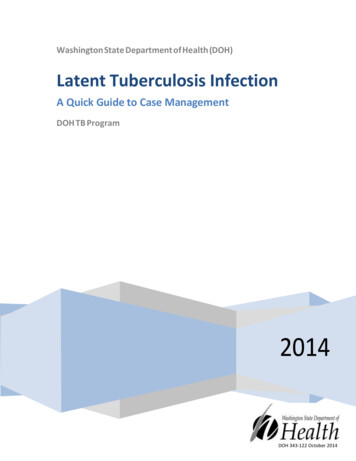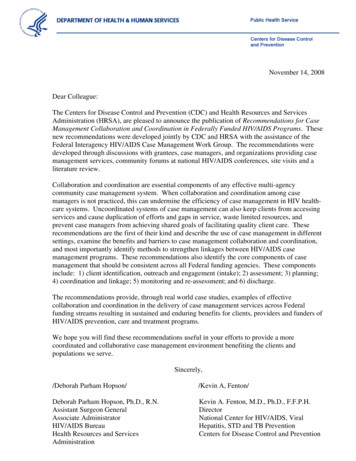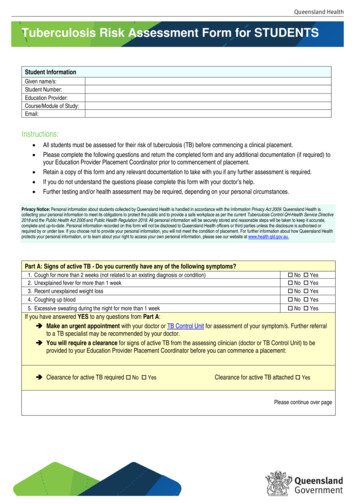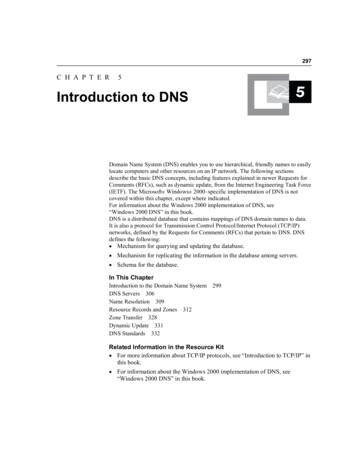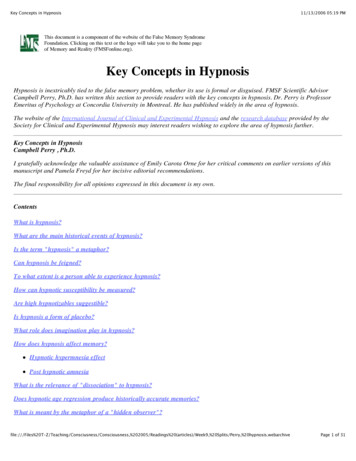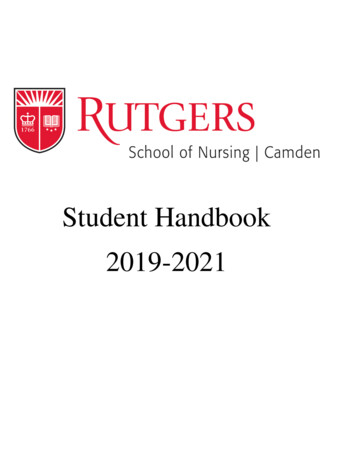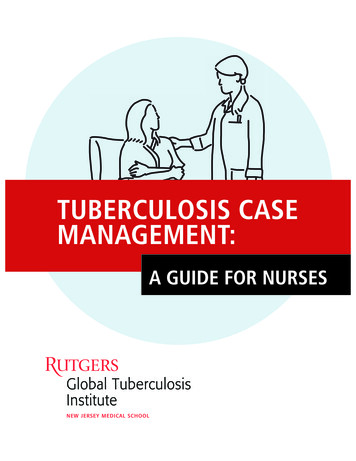
Transcription
TUBERCULOSIS CASEMANAGEMENT:A GUIDE FOR NURSES
blank
TUBERCULOSIS CASEMANAGEMENT:A GUIDE FOR NURSESThis material was supported by the grant U52PS004090 funded by the Centers for Disease Control and Prevention.Its contents are solely the responsibility of the authors and do not necessarily represent the official views of theCenters for Disease Control and Prevention or the Department of Health and Human Services.i
ACKNOWLEDGEMENTSThe Global Tuberculosis Institute wishes to acknowledge the following individuals for their valuablecontributions:REVISED EDITION: 2017Document Prepared ByNisha Ahamed, MPH; Anita Khilall, MPH; Patricia Woods, MSN, RNCase Study ContributorsProviding Patient-Centered Care: Danielle Weber, MS, RNMedically Complex TB in a Child: Lillian Pirog, RN, PNP; Suzanne Tortoriello, MSN, RN, APN-CCoping with a Dual Diagnosis: Dianne Fyffe-Washington, BSN, RNTB in a Patient Experiencing Homelessness: Midia Fulano, MPH, BSN, RN; Sarah Koch, BSN, MS, RN;Helen Townsend, MPH, RNTB in a Recently Incarcerated Patient: Ellen Murray, PhD, BSNReviewersCarolyn Bargman, MA, RN-CRajita Bhavaraju, PhD, MPHMarybeth Caruso, RN, FN-CSAJanet Cashman, RN-BCSally Cook, RNDorothy Freeman, MSN, RNKaren Galanowsky, MPH, BSN, RNShirlee Hasstedt, BSN, RNCherie Helfrich, MSN, RNLaurie Hickstein, MPH, BSN, RNPatricia Iyer, MSN, RN, BCLynette Leviste, BSN, PHNAmy Lewis, MPH, MCHESDJ McCabe, MSN, RNMary Ellen Moskowite, BSN, PHNMaureen Murphy-Weiss, BSN, RN, CPMMa Kine Min Naing, BSN, RN, PHNEileen Napolitano, BALarry Niler, MS, RN, CICLillian Pirog, RN, PNPEva Reeder, BSN, PHNKaren Smith-Sayer, MSN, RNDebra Stephens, MPH, BSN, RNSuzanne Tortoriello, MSN, RN, APN-CKimberly Townsend, MPA, BSN, RNDanielle Weber, MS, RNNeeds Assessment Participants: Sally Cook, RN; John Caban, BSN; Maria Dalbey, MA, MBA, BSN, RN, RT (AART);Maureen Donovan, MGA, BSN, RN; Mimi Ford, RN, CCRN; Elizabeth Foy, BSN, BA; Karen Galanowsky, MPH, BSN, RN;Maryann Kuras, BA, RN; Karen Martinek, MPH, BSN, RN; Debbie Onofre, BSN, RN; Michele Roth, BSN; Esther Rudnick, BSN, RN;Judith B. Thomas, BSN, RN; Julie Tomoro, BSN, RN; Kimberly Townsend, MPA, BSN, RN; Christine Treadway, BS, CCM, ACLS, BLS;Elizabeth Zeringue, MPH, BSN, RNMany thanks to the reviewers and case study contributors who generously shared their ‘Tricks of the Trade’ with us.Graphic Design: Judith RewORIGINAL EDITION: 2001Original document prepared by: Minnie Campbell, DNSc, RN; Karen Galanowsky, MPH, BSN, RN; Debra Kantor, PhD;DJ McCabe, MSN, RN; Lillian Pirog, RN, PNP; Suzanne Tortoriello, MSN, RN, APN-CReviewers: Jo-Ann Arnold, RNC, BSN, MS; Judy Gibson, MSN, RN; Marty Huber, MPH, RN; Patricia J. Moulton, PhD, RNAll material in this document is in the public domain and may be used and reprinted without special permission; citation as tosource, however, is appreciated. Suggested Citation: Global Tuberculosis Institute. Tuberculosis Case Management: A Guide forNurses. 2017: (inclusive page numbers).iiTuberculosis Case Management: A Guide for Nurses
TABLE OF CONTENTSINTRODUCTION . 1Chapter 1: Fundamentals of Tuberculosis Nurse Case ManagementI.II.INTRODUCTION. 6BACKGROUND CONCEPTS . 6a. Core Functions of Public Health . 6b. The Nursing Process . 9c. Case Management . 10III.TUBERCULOSIS NURSE CASE MANAGEMENT . 12a. Goals of TB Nurse Case Management. 13b. Elements and Activities of the TB Nurse Case Management Process . 13IV.CONTACT INVESTIGATION . 29V.COLLABORATING WITH COMMUNITY AGENCIES AND PRIVATE PROVIDERS . 32VI. DELEGATION IN TUBERCULOSIS NURSE CASE MANAGEMENT . 34VII. SUMMARY . 35APPENDICES. 36Appendix 1: Patient Education Documentation Form . 36Appendix 2: Examples of Intermediate Outcomes in TB Case Management . 37Appendix 3: Examples of Expected Outcomes in TB Case Management . 38Appendix 4: Example of Chart Review. 39Appendix 5: Sample Update Request Letter and Form for PatientsTreated by Private or Community Providers . 40RESOURCE LIST . 42Chapter 2: Providing Patient-Centered Tuberculosis CareI.INTRODUCTION. 44a. Key Elements of Patient-Centered TB Care. 44b. Providing Culturally Responsive Care . 45II.STRATEGIES AND RECOMMENDATIONS FOR PATIENT-CENTERED CAREIN TUBERCULOSIS NURSE CASE MANAGEMENT .49a. Approaches to Ensuring Adherence and Treatment Success . 49b. Addressing Organizational Barriers . 60c. Sample Care Plan . 60iii
III.CASE STUDY: PROVIDING PATIENT-CENTERED CARE . 63IV.SUMMARY . 67APPENDIX: CULTURAL AWARENESS SELF-ASSESSMENT CHECKLIST . 68RESOURCE LIST . 70Chapter 3: Special Situations and CircumstancesI.INTRODUCTION. 72II.TUBERCULOSIS IN CHILDREN AND ADOLESCENTS . 73a. Case Study: Medically Complex TB in a Child. 79III.DIABETES AND TUBERCULOSIS . 82IV.HIV AND TUBERCULOSIS. 84a. Case Study: Coping with a Dual Diagnosis. 86V.MENTAL HEALTH AND TUBERCULOSIS . 89VI. HOMELESSNESS AND TUBERCULOSIS . 91a. Case Study: TB in a Patient Experiencing Homelessness . 93VII. SUBSTANCE USE AND TUBERCULOSIS. 96VIII. TUBERCULOSIS SCREENING IN IMMIGRANTS AND REFUGEES . 98IX. TUBERCULOSIS IN CORRECTIONAL SETTINGS .101a. Case Study: TB in a Recently Incarcerated Patient .104X.SUMMARY .107APPENDIX: COMMON CHALLENGES FOR PEOPLE EXPERIENCING HOMELESSNESS .108RESOURCE LIST .109References. 112ivTuberculosis Case Management: A Guide for Nurses
INTRODUCTIONAccording to the World Health Organization (WHO), health is “a state of complete physical,mental, and social well-being and not merely the absence of disease” (2017). This encompassingdefinition is implicit in the discipline of public health, which is the science and art of preventingdisease, prolonging life, and promoting health. Looking at the definition from a holisticperspective, the Institute of Medicine defined public health as “what we, as a society do,collectively, to assure the conditions in which people can be healthy” (Institute of MedicineCommittee for the Study of the Future of Public Health, 1988).For tuberculosis (TB) nurse case managers, the focus of nursing practice is the individual sick withTB, and his or her impact on the health status of individuals, families, and groups who live andwork in their respective community. The nurse case manager applies fundamental concepts ofpublic health, including social, economic, ecologic, and global factors to facilitate all aspects of TBcare and improve and protect the health of the individual and the greater community.This document, Tuberculosis Case Management: A Guide for Nurses, was developed by the GlobalTuberculosis Institute at Rutgers, The State University of New Jersey as a guide for staff at agenciesor facilities who utilize or wish to implement a TB nurse case management system. The guide isdesigned to provide the reader with an understanding of the nurse case management processand how it is applied both when caring for patients with TB and in ensuring appropriate practicesin TB prevention and control in the community. It focuses on the rationale for, and activities of TBcase management for nurses, and is not intended to provide complete information on TB or TBnursing. We recommend that readers have a thorough understanding of the TB disease process,etiology, pathogenesis, diagnosis, treatment, and related nursing activities for TB infection and TBdisease, as well as TB contact investigation, all of which inform the TB case management activitiescarried out by nurses.The primary audience for this guide is nurses working within local or state public health settings(e.g., state or local health departments or chest clinics) who are, or will be, responsible for casemanagement of patients with TB disease and TB infection (which is sometimes called latent TBinfection or LTBI). Since the guide is intended for nurses, the terms nurse case manager and casemanager are used interchangeably.The guide was initially published as a set of self-study modules. To address the currentepidemiology of TB in the United States (US) and challenges faced by TB nurse case managerstoday, this edition has been updated to include a new section on nurse case managementapproaches and interventions for specific groups or populations.1
The guide is organized into three sections as follows:Chapter 1: Fundamentals of Tuberculosis Nurse Case ManagementThis chapter describes core functions of public health, the nursing process, and case managementas well as the key activities of TB case management. Brief information on contact investigation,collaborating with community providers, and delegation is also included.Chapter 2: Providing Patient-Centered Tuberculosis CareThis chapter focuses on patient-centered TB care and describes strategies and approaches toimprove adherence. A case study highlights patient-centered TB case management.Chapter 3: Tuberculosis Nurse Case Management in Special Situations and CircumstancesThis chapter provides information and case studies on TB in selected situations and circumstances,ranging from TB in people experiencing homelessness to those with TB and diabetes. Specificconsiderations in TB nurse case management for each co-morbidity or situation are identified, witha focus on practical approaches. A brief introduction regarding the condition and its impact on orinteraction with TB is included, but this is not intended provide complete information on diagnosis,management, and treatment of TB in these situations.Each chapter also includes appendices (e.g., tools, forms, or supplemental information) and aresource list.The case studies included in this guide were provided by practicing public health nurses and presentthe activities and interventions implemented by those nurses within their TB program. The cases areintended as examples of effective TB case management. However, guidelines and practices vary byjurisdiction, so these activities may not be consistent with practices in other TB programs. TB nursecase managers utilizing this guide should follow the rules and regulations within their state or localTB program and should be familiar with national guidelines for the diagnosis and management ofTB, which can be accessed at: cdc.gov/tb/publications/guidelines/default.htmThe “Tricks of the Trade” included in the guide were also contributed by experienced public healthnurses. These practical tips and suggestions are based on their many years of providing TB casemanagement services.We recognize that resources vary greatly and in many clinics and health departments the roleof TB nurse and TB case manager may overlap, or one nurse may carry out both roles. Somehealth departments provide TB services using multidisciplinary teams that may include diseaseinvestigators, outreach workers, social workers, or others. We have made every attempt to makethe content as universal as possible for applicability in a variety of locations and settings.2Tuberculosis Case Management: A Guide for Nurses
We recommend review of the Core Curriculum on Tuberculosis: What the Clinician ShouldKnow and Self-Study Modules on Tuberculosis published by the Centers for Disease Control andPrevention (CDC) for the essential TB background that is a prerequisite for understanding andusing this guide. These and other materials can be accessed at:cdc.gov/tb/education/provider edmaterials.htmIn addition, the National Tuberculosis Nurse Coalition (NTNC) has developed several resourcesthat provide useful information on TB nursing and TB nurse case management, including corecompetencies for TB nurse case managers and the manual Tuberculosis Nursing: A ComprehensiveGuide to Patient Care. These and other NTNC materials can be accessed at:tbcontrollers.org/ntnc/Finally, the TB Training Roadmap for Public Health Nurses includes a wide range of existingresources for nurses who are new to the field of TB prevention and control. The Roadmap is alsouseful for nurses who carry out TB case management activities and can be accessed on the GlobalTuberculosis Institute website productfolder/roadmap.php3
4Tuberculosis Case Management: A Guide for Nurses
CHAPTER 1Fundamentals of TuberculosisNurse Case Management5
I.INTRODUCTIONSince TB is an airborne infectious disease that impacts public health, efforts to prevent and controlTB in the United States are centered within the public health system. Though there are manypartners in TB prevention and control, and TB clinical care can occur in many settings, TB casemanagement takes place primarily within state or local health departments. Nurses represent thelargest segment of the public health workforce (Association of Public Health Nurses, 2017) andplay an essential role in health departments and TB programs. Using the nursing process, theycarry out essential public health activities. Thus, the tasks, activities, and responsibilities of nursesproviding TB case management are situated within the framework of public health, the nursingprocess, and the case management approach. In order to specifically discuss TB case managementfor nurses, it is important to understand and recognize the interaction between public health,the nursing process, and case management. This chapter addresses the core functions of publichealth and the nursing process as they relate to case management, specifically TB nurse casemanagement.II.BACKGROUND CONCEPTSa. Core Functions of Public HealthPublic health is the science of protecting and improving the health of individuals and communitiesthrough promotion of healthy lifestyles, research for disease and injury prevention, and detectionand control of infectious diseases. Overall, public health is concerned with protecting the health ofentire populations (CDC Foundation, 2017).These objectives are achieved through the implementation of the core functions of public healthwhich include assessment, policy development, and assurance, as well as research that serves allcore functions. The core functions comprise a framework of ten essential public health services,which is the basis of the National Public Health Performance Standards developed by CDC.Figure 1 illustrates this framework of the ten essential public health services that should beundertaken by all communities.6Tuberculosis Case Management: A Guide for Nurses
ASSESSMSysASSURANCEEnforceLawsManagemeDiagnose& POLICYDEVLink kforceTENEvaluateNTMEOPELThe Ten Essential Public Health ServicesFIGURE 1: This figure shows a model of the framework of the core functions of public healthand the ten essential public health services, which are detailed in the table below.Source: “The Public Health System & the 10 Essential Public Health Services” (CDC, 2017b).Assessment1. Monitor health status to identify community health problems.2. Diagnose and investigate health problems and health hazards in the community.Policy Development3. Inform, educate, and empower people about health issues.4. Mobilize community partnerships to identify and solve health problems.5. Develop policies and plans that support individual and community health efforts.Assurance6. Enforce laws and regulations that protect health and ensure safety.7. Link people to needed personal health services and assure the provision of health carewhen otherwise unavailable.8. Assure a competent public health and personal health care workforce.9. Evaluate effectiveness, accessibility, and quality of health services.Research Serving All Functions10. Research for new insights and innovative solutions to health problems.7
These services are carried out by a variety of health care workers, including nurses. Although notall of the activities carried out within the framework will be performed by nurses, TB nurse casemanagers do have a role in each of the ten essential public health services.In the public health framework, the core functions are as follows:Assessment is comprised of systematic data collection, monitoring, and providing informationabout the health of a community. As it relates to TB, data are collected regarding the number ofindividuals with TB disease (and sometimes TB infection) in a community. Data are then analyzedto measure the success of efforts to treat those individuals and to prevent transmission of thedisease (as measured by the occurrence of newly diagnosed individuals with TB, sometimesreferred to as TB cases). An assessment of potential TB exposure in contacts of persons diagnosedwith or being evaluated for inf
This document, Tuberculosis Case Management: A Guide for Nurses, was developed by the Global Tuberculosis Institute at Rutgers, The State University of New Jersey as a guide for staff at agencies or facilities who utilize or wish to implement a TB nurse case management system.File Size: 732KB
